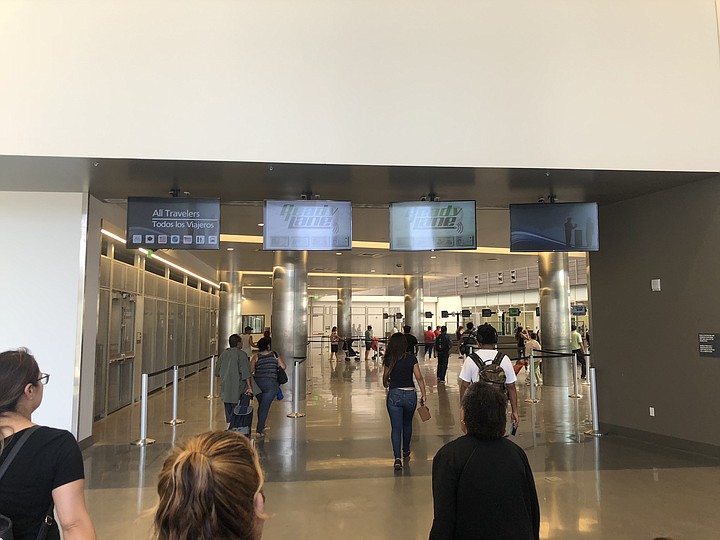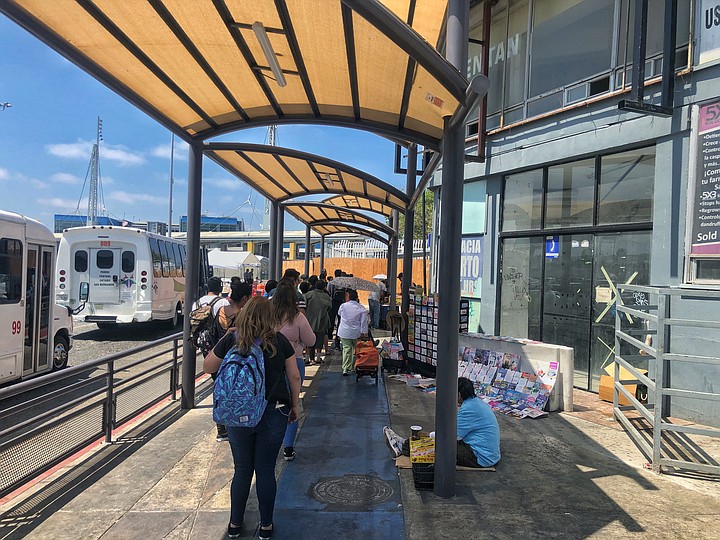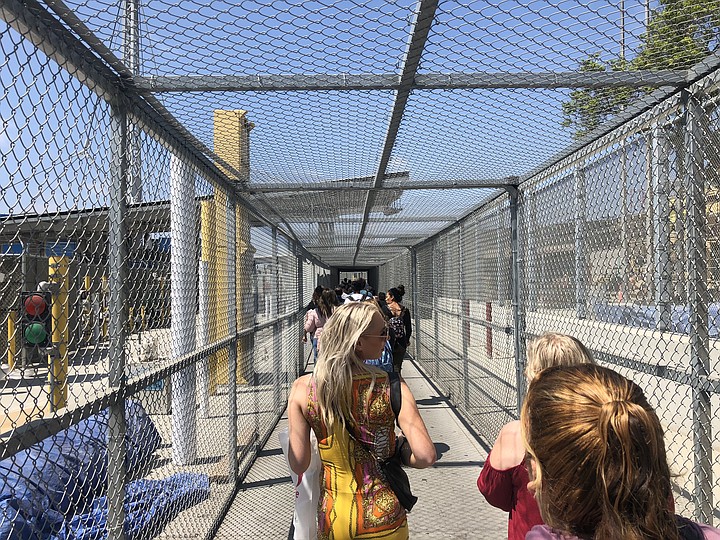 Facebook
Facebook
 X
X
 Instagram
Instagram
 TikTok
TikTok
 Youtube
Youtube

I remember the first time I crossed the border as a pedestrian from San Ysidro to Tijuana. It was early 2010, the pedestrian entry lay on the west side of the 5. It was a simple walk past a tall oxidized revolving gate that opened to an L-shaped hallway where wachos (soldiers) stood guard.

Another small metal revolving gate led you to Estación Federal, now a trendy collective of apartments and businesses. What was left of the open hallway, is currently used as a parking lot for Mexican government vehicles. The old metal gate was moved to Calle Ocho as a display for a park built in 2016 in where the police headquarters used to be.

The border crossing known as El Chaparral moved to the east side of the car traffic in 2013. The dynamic switched to two small revolving gates and a free flow of pedestrian traffic through a small room with two agents who rarely checked people.

The Mexican government then opened a new facility in 2015. The days of crossing the border to Mexico freely as a pedestrian ended. Now foreigners and Mexican nationals must show proper documentation to cross into Tijuana or can get sent back (though sometimes they let foreigners slide with an ID).

Puerta a Mexico, which used to be a pedestrian bridge and government building known as La Concha, stretched over the line of cars waiting to cross the border. It was demolished in 2015 and no pedestrian bridge was ever built to replace it.
PedWest, a northbound pedestrian entry west of the traffic opened on July 2016. Mexico, seemingly unaware of the grand opening, improvised an eerie bridge that lasted half a year before building what is now a long bridge that ends in Plaza Las Américas. A year later, the southbound entry through PedWest was opened under the bridge (note: northbound access is 24/7, while southbound is limited from 6 am to 10 pm).
The opening of PedWest gave pedestrian border crossers two options La Viejita or PedWest. La Viejita, or the Old One, referred to the original customs house built in 1933 used while the border went under major surgery. Because of its tight space, La Viejita became the second choice for most pedestrian border crossers, though handicapped people preferred it for its proximity to the trolley station (PedWest is a long walk).
Two weeks ago, on August 15, La Viejita became La Nueva, also known as PedEast.
"The border always has something new. It was super fast, took me less than five minutes," commented my friend Marc who visits once a year from New York and crossed the new border a few days after the opening.
"It's mostly free, there was a line only one day, and it only took like 30 minutes," commented daily border crosser, Christian Cardenas.
"Like all that is new, it is shiny. The flow of people was fast, and the line was much shorter than PedWest. And it also has a special lane for handicapped people," said Paola Valdivia, another daily border crosser. "Don't cross PedEast today," Paola messaged me a couple days later. "There was a ton of line in the morning, I went to PedWest instead and it was empty."
I went to check out La Nueva PedEast a week after the opening, Thursday at 1:48 pm. A short disorganized line of around 30 people gathered around near the entrance seemingly confused (and I was one of them), three buses with people were on my left. I made my way to the front asking if there were two lines for regular or Ready Lane. “Es solo una línea,” shouted a man who sells books near the entrance. There was another line to the left of the disorganized line for the people who pay the $6 bus scam that takes you across the border.
More confused people arrived while I waited, most of them walking to the front to ask, then to the back of the line. A handful of people played dumb and cut in line way in front of me (two of them cut with the bus line). With no security around or no organization, no one said anything. Just five minutes after waiting, the line tripled in size, reaching the pedestrian bridge (around 100 people). I was let into the building 18 minutes after my arrival.
Though the new border is open 24/7 to the public, it is not complete. The main entrance is non-existent at the moment, they do a quick check of documents under an improvised tent next to plywood covering the entrance. A short walk through a caged hallway follows, and it finally opens up to a new blue and grey, square and modern looking building double the size of PedWest.
PedEast has 22 inspection lanes though only half have agents working. Adding PedWest, there are 36 pedestrian northwest lanes total, but not enough agents to work. There are secondary inspection offices on the back, a metal scanner, and bathrooms. “I don’t know, probably in the future. For now, go to Otay,” answered a border patrol agent when I asked him if PedEast had a SENTRI office.
I crossed two days later (on Saturday afternoon), and there was no wait. The small gate that is next to the inspection lane malfunctioned after the agent was trying to let me through.
Despite the lack of agents working the inspection lanes in both PedWest and PedEast, the pedestrian crossing is the best way to visit the city. The vehicle border lanes have been disastrous most of this summer; waiting times reached beyond four hours in the regular and Ready lanes.


I remember the first time I crossed the border as a pedestrian from San Ysidro to Tijuana. It was early 2010, the pedestrian entry lay on the west side of the 5. It was a simple walk past a tall oxidized revolving gate that opened to an L-shaped hallway where wachos (soldiers) stood guard.

Another small metal revolving gate led you to Estación Federal, now a trendy collective of apartments and businesses. What was left of the open hallway, is currently used as a parking lot for Mexican government vehicles. The old metal gate was moved to Calle Ocho as a display for a park built in 2016 in where the police headquarters used to be.

The border crossing known as El Chaparral moved to the east side of the car traffic in 2013. The dynamic switched to two small revolving gates and a free flow of pedestrian traffic through a small room with two agents who rarely checked people.

The Mexican government then opened a new facility in 2015. The days of crossing the border to Mexico freely as a pedestrian ended. Now foreigners and Mexican nationals must show proper documentation to cross into Tijuana or can get sent back (though sometimes they let foreigners slide with an ID).

Puerta a Mexico, which used to be a pedestrian bridge and government building known as La Concha, stretched over the line of cars waiting to cross the border. It was demolished in 2015 and no pedestrian bridge was ever built to replace it.
PedWest, a northbound pedestrian entry west of the traffic opened on July 2016. Mexico, seemingly unaware of the grand opening, improvised an eerie bridge that lasted half a year before building what is now a long bridge that ends in Plaza Las Américas. A year later, the southbound entry through PedWest was opened under the bridge (note: northbound access is 24/7, while southbound is limited from 6 am to 10 pm).
The opening of PedWest gave pedestrian border crossers two options La Viejita or PedWest. La Viejita, or the Old One, referred to the original customs house built in 1933 used while the border went under major surgery. Because of its tight space, La Viejita became the second choice for most pedestrian border crossers, though handicapped people preferred it for its proximity to the trolley station (PedWest is a long walk).
Two weeks ago, on August 15, La Viejita became La Nueva, also known as PedEast.
"The border always has something new. It was super fast, took me less than five minutes," commented my friend Marc who visits once a year from New York and crossed the new border a few days after the opening.
"It's mostly free, there was a line only one day, and it only took like 30 minutes," commented daily border crosser, Christian Cardenas.
"Like all that is new, it is shiny. The flow of people was fast, and the line was much shorter than PedWest. And it also has a special lane for handicapped people," said Paola Valdivia, another daily border crosser. "Don't cross PedEast today," Paola messaged me a couple days later. "There was a ton of line in the morning, I went to PedWest instead and it was empty."
I went to check out La Nueva PedEast a week after the opening, Thursday at 1:48 pm. A short disorganized line of around 30 people gathered around near the entrance seemingly confused (and I was one of them), three buses with people were on my left. I made my way to the front asking if there were two lines for regular or Ready Lane. “Es solo una línea,” shouted a man who sells books near the entrance. There was another line to the left of the disorganized line for the people who pay the $6 bus scam that takes you across the border.
More confused people arrived while I waited, most of them walking to the front to ask, then to the back of the line. A handful of people played dumb and cut in line way in front of me (two of them cut with the bus line). With no security around or no organization, no one said anything. Just five minutes after waiting, the line tripled in size, reaching the pedestrian bridge (around 100 people). I was let into the building 18 minutes after my arrival.
Though the new border is open 24/7 to the public, it is not complete. The main entrance is non-existent at the moment, they do a quick check of documents under an improvised tent next to plywood covering the entrance. A short walk through a caged hallway follows, and it finally opens up to a new blue and grey, square and modern looking building double the size of PedWest.
PedEast has 22 inspection lanes though only half have agents working. Adding PedWest, there are 36 pedestrian northwest lanes total, but not enough agents to work. There are secondary inspection offices on the back, a metal scanner, and bathrooms. “I don’t know, probably in the future. For now, go to Otay,” answered a border patrol agent when I asked him if PedEast had a SENTRI office.
I crossed two days later (on Saturday afternoon), and there was no wait. The small gate that is next to the inspection lane malfunctioned after the agent was trying to let me through.
Despite the lack of agents working the inspection lanes in both PedWest and PedEast, the pedestrian crossing is the best way to visit the city. The vehicle border lanes have been disastrous most of this summer; waiting times reached beyond four hours in the regular and Ready lanes.
Comments